Rembo Bongo, Part 1
Last week I went back up the Rembo Bongo (river) on the north side of N’dogo Lagoon for 5 days. I was there in September 2007, but it was still the dry season, and I found out through interviews with villagers that the manatees only come up in the rainy season. So this year I waited until well into the rainy season before heading back up there.
Map detail of N’dogo Lagoon and the surrounding area, all of it is located in central Gabon. The Rembo Bongo and most of the lakes (Longa Longa is north of Kivoro, off the map) are in the upper right.
 This time a hippo researcher named Sylvie joined DeDe and I on the trip. We boated across the southern end of N’dogo Lagoon to the mouth of the Rembo Bongo, then boated about 2 hours up to the only village, Ingoueka, where we set up camp.
This time a hippo researcher named Sylvie joined DeDe and I on the trip. We boated across the southern end of N’dogo Lagoon to the mouth of the Rembo Bongo, then boated about 2 hours up to the only village, Ingoueka, where we set up camp.Forest and hilly savannah view in southern N’dogo lagoon as we head to the river.  The Rembo Bongo divides into 2 channels at it’s mouth into the lagoon- one is a palm-lined corridor (below), the other is a deeper, wider channel lined with papyrus and grasses.
The Rembo Bongo divides into 2 channels at it’s mouth into the lagoon- one is a palm-lined corridor (below), the other is a deeper, wider channel lined with papyrus and grasses.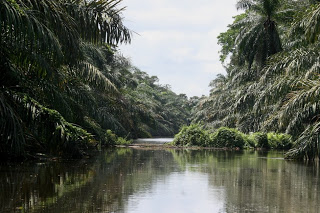
 Our campsite was actually on the front porch of the infirmary because there’s a nice roof to shelter us from the constant rain. That’s Sylvie on the front step.
Our campsite was actually on the front porch of the infirmary because there’s a nice roof to shelter us from the constant rain. That’s Sylvie on the front step. Tents on the front porch
Tents on the front porch Each day we set out from Ingoueka to survey the six lakes that are adjacent to the river. In the dry season the lakes are very shallow and are bordered by open fields that are then surrounded by pristine forest. Elephants, buffalo and antelope graze the grasses. When the rainy season comes, however, the lakes flood and the water level rises 2-3 meters (6.5-10 feet), submerging the grasses. The terrestrial animals move back into the forest and the manatees arrive to graze on the abundant plants: papyrus roots, grasses and water lilies.
Each day we set out from Ingoueka to survey the six lakes that are adjacent to the river. In the dry season the lakes are very shallow and are bordered by open fields that are then surrounded by pristine forest. Elephants, buffalo and antelope graze the grasses. When the rainy season comes, however, the lakes flood and the water level rises 2-3 meters (6.5-10 feet), submerging the grasses. The terrestrial animals move back into the forest and the manatees arrive to graze on the abundant plants: papyrus roots, grasses and water lilies.
The first day we went to the northernmost lake, Longa Longa. On our way upriver we found a large dead softshell turtle (Trionyx triunguis), a dead snake that had gotten caught in a fishing net while swimming across the river, and a dead juvenile elephant. Suffice it to say the elephant was so decomposed that it took us several minutes to identify it, so I’ll spare you a photo. We were relieved that it wasn’t another manatee! We also saw some beautiful wild orchids and lots of neat birds. The river is fast-flowing and the color of chocolate milk, so that combined with the sound of the motor mostly precludes us from seeing any manatees that might be there.
DeDe with the dead turtle  Wild orchid with pretty yellow flowers
Wild orchid with pretty yellow flowers  Long Longa turned out to be spectacular. We boated among partially submerged trees and up coves into the forest. We spent most of the day surveying all around the lake and had 5 manatee sightings (6 individuals) which is fantastic! A couple times we were able to follow them across the glass smooth water by their bubble trails, made as they swim across the very fine sediment, releasing bubbles trapped under decaying foliage on the bottom. At one point two manatees surfaced together and I had about a millisecond to snap a picture. I finally captured a manatee nose, but of course it’s blurry.
Long Longa turned out to be spectacular. We boated among partially submerged trees and up coves into the forest. We spent most of the day surveying all around the lake and had 5 manatee sightings (6 individuals) which is fantastic! A couple times we were able to follow them across the glass smooth water by their bubble trails, made as they swim across the very fine sediment, releasing bubbles trapped under decaying foliage on the bottom. At one point two manatees surfaced together and I had about a millisecond to snap a picture. I finally captured a manatee nose, but of course it’s blurry.
trees in Lac Longa Longa 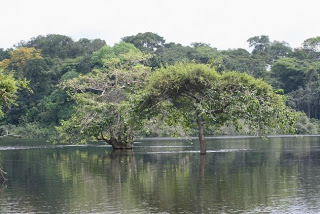
 Bubble trails allow me to see where the manatee is swimming, even when they make u-turns!
Bubble trails allow me to see where the manatee is swimming, even when they make u-turns!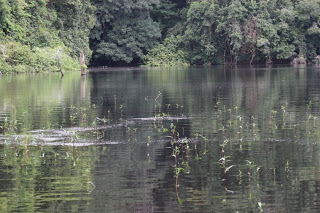 Yes, that’s the nose. Trust me, it is really hard to see these guys, much less photograph them! But I’ll keep trying.
Yes, that’s the nose. Trust me, it is really hard to see these guys, much less photograph them! But I’ll keep trying. 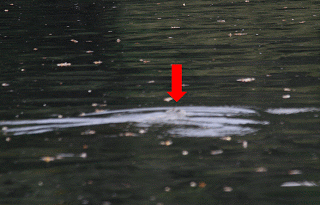 Later that afternoon we went to Lac Kivoro, just south of Longa Longa. I had underestimated the size of these lakes (they literally increase 3 to 5 times their size from the dry season), so we were only able to survey part of it before afternoon thunderstorms chased us back to the village.
Later that afternoon we went to Lac Kivoro, just south of Longa Longa. I had underestimated the size of these lakes (they literally increase 3 to 5 times their size from the dry season), so we were only able to survey part of it before afternoon thunderstorms chased us back to the village.
Rain shower heading towards Lac Kivoro

Lac Kivoro in the rain. Despite the higher water level, there are still some shallower places where grass protrudes.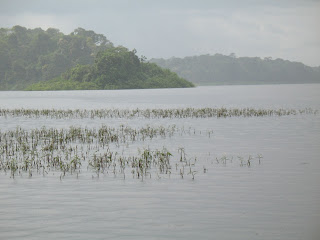

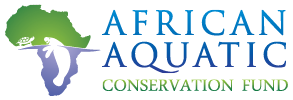

No Comments